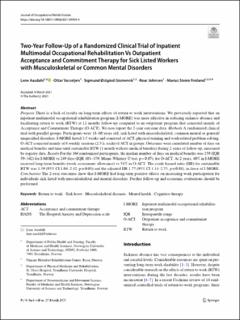| dc.contributor.author | Aasdahl, Lene | |
| dc.contributor.author | Vasseljen, Ottar | |
| dc.contributor.author | Gismervik, Sigmund Østgård | |
| dc.contributor.author | Johnsen, Roar | |
| dc.contributor.author | Fimland, Marius Steiro | |
| dc.date.accessioned | 2021-04-12T13:58:16Z | |
| dc.date.available | 2021-04-12T13:58:16Z | |
| dc.date.created | 2021-04-09T07:36:55Z | |
| dc.date.issued | 2021 | |
| dc.identifier.issn | 1053-0487 | |
| dc.identifier.uri | https://hdl.handle.net/11250/2737376 | |
| dc.description.abstract | Purpose There is a lack of results on long-term effects of return to work interventions. We previously reported that an inpatient multimodal occupational rehabilitation program (I-MORE) was more effective in reducing sickness absence and facilitating return to work (RTW) at 12 months follow-up compared to an outpatient program that consisted mainly of Acceptance and Commitment Therapy (O-ACT). We now report the 2-year outcome data. Methods A randomized clinical trial with parallel groups. Participants were 18–60 years old, sick listed with musculoskeletal, common mental or general/unspecified disorders. I-MORE lasted 3.5 weeks and consisted of ACT, physical training and work-related problem solving. O-ACT consisted mainly of 6 weekly sessions (2.5 h. each) of ACT in groups. Outcomes were cumulated number of days on medical benefits and time until sustainable RTW (1 month without medical benefits) during 2-years of follow-up, measured by registry data. Results For the 166 randomized participants, the median number of days on medical benefits was 159 (IQR 59–342) for I-MORE vs 249 days (IQR 103–379; Mann–Whitney U test, p = 0.07), for O-ACT. At 2 years, 40% in I-MORE received long-term benefits (work assessment allowance) vs 51% in O-ACT. The crude hazard ratio (HR) for sustainable RTW was 1.59 (95% CI 1.04–2.42, p = 0.03) and the adjusted HR 1.77 (95% CI 1.14–2.75, p = 0.01), in favor of I-MORE. Conclusions The 2-year outcomes show that I-MORE had long-term positive effects on increasing work participation for individuals sick listed with musculoskeletal and mental disorders. Further follow-up and economic evaluations should be performed. | en_US |
| dc.language.iso | eng | en_US |
| dc.publisher | Springer | en_US |
| dc.relation.uri | https://link.springer.com/article/10.1007%2Fs10926-021-09969-4 | |
| dc.rights | Navngivelse 4.0 Internasjonal | * |
| dc.rights.uri | http://creativecommons.org/licenses/by/4.0/deed.no | * |
| dc.title | Two‑Year Follow‑Up of a Randomized Clinical Trial of Inpatient Multimodal Occupational Rehabilitation Vs Outpatient Acceptance and Commitment Therapy for Sick Listed Workers with Musculoskeletal or Common Mental Disorders | en_US |
| dc.type | Peer reviewed | en_US |
| dc.type | Journal article | en_US |
| dc.description.version | publishedVersion | en_US |
| dc.source.journal | Journal of occupational rehabilitation | en_US |
| dc.identifier.doi | https://doi.org/10.1007/s10926-021-09969-4 | |
| dc.identifier.cristin | 1903120 | |
| dc.relation.project | Norges forskningsråd: 238015 | en_US |
| dc.description.localcode | Open Access This article is licensed under a Creative Commons Attribution 4.0 International License, which permits use, sharing, adaptation, distribution and reproduction in any medium or format, as long as you give appropriate credit to the original author(s) and the source, provide a link to the Creative Commons licence, and indicate if changes were made. The images or other third party material in this article are included in the article's Creative Commons licence, unless indicated otherwise in a credit line to the material. If material is not included in the article's Creative Commons licence and your intended use is not permitted by statutory regulation or exceeds the permitted use, you will need to obtain permission directly from the copyright holder. To view a copy of this licence, visit http://creativecommons.org/licenses/by/4.0/. | en_US |
| cristin.ispublished | true | |
| cristin.fulltext | original | |
| cristin.qualitycode | 1 | |

